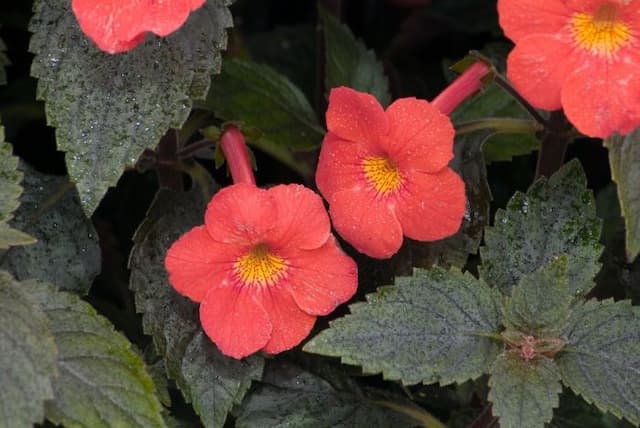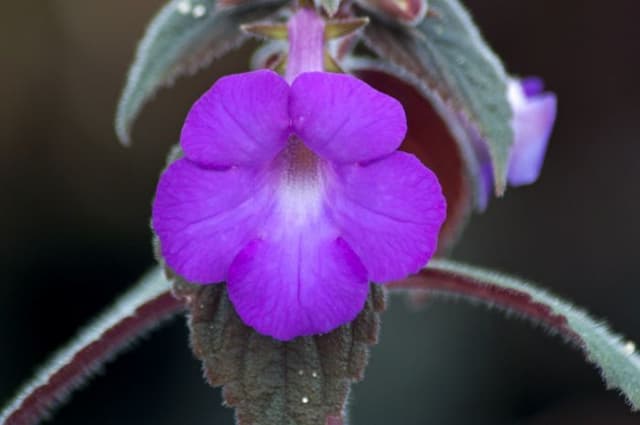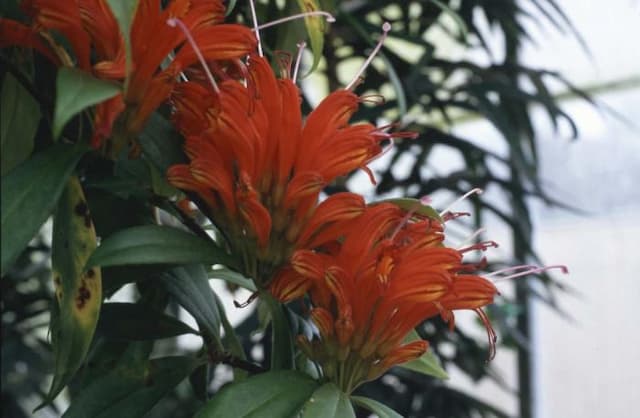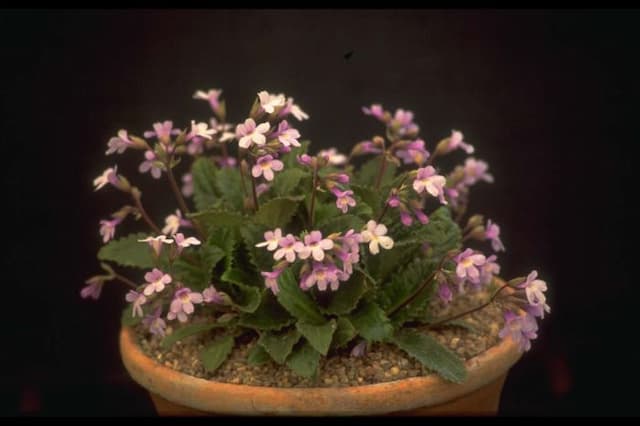Cape Primrose Streptocarpus 'Melanie' Dibley

ABOUT
Streptocarpus 'Melanie' Dibley, often referred to as Cape primrose, showcases a striking appearance that is sure to catch the eye in any indoor plant collection. This vibrant houseplant bears lush, velvety foliage that usually presents itself in a deep green hue, providing a rich backdrop for its blooms. The leaves are elongated and have a soft, almost furry texture, which emanates a lushness in the overall presentation of the plant. The true spectacle of the Cape primrose, however, lies in its flowers. With a flourish of color, the blossoms of Streptocarpus 'Melanie' Dibley are large and showy. They typically appear in shades of blue, violet, or purple, often with ornate markings or throats that can feature contrasting hues such as yellow or white. These throat markings can include stripes, spots, or a combination, adding a layer of complexity to the visual appeal of the blossoms. Each trumpet-shaped flower emerges from a slender, delicate stem, exuding an elegant and graceful air. The arrangement of the flowers on these stems is such that they create an impressive display of color above the foliage, almost resembling a miniature bouquet. This balance of vibrant flowers against the soft, wide leaves makes the Cape primrose a sought-after ornamental plant, celebrated for its long flowering period and its ability to brighten up indoor spaces with its cheerful blooms.
About this plant
 Names
NamesFamily
Gesneriaceae
Synonyms
Cape Primrose, African Violet Cousin
Common names
Streptocarpus 'Melanie' Dibley.
 Toxicity
ToxicityTo humans
Cape Primrose, Streptocarpus 'Melanie' Dibley, is generally not considered toxic to humans. There are no well-documented cases of poisoning from ingesting this plant, and it is not known to cause any harmful effects. However, it's always advisable to avoid consuming parts of ornamental plants due to potential individual allergic reactions or the presence of pesticides.
To pets
Cape Primrose is not known to be toxic to pets. There are no common reports of poisoning in pets such as cats and dogs from ingesting this plant, and it is considered non-toxic by major animal welfare organizations. As with humans, pets should not consume ornamental plants, and it's always wise to prevent pets from eating plants to avoid any potential stomach upset or individual allergic reactions.
 Characteristics
CharacteristicsLife cycle
Perennials
Foliage type
Evergreen
Color of leaves
Green
Flower color
Varies
Height
1 foot (30 centimeters)
Spread
1 foot (30 centimeters)
Plant type
Herb
Hardiness zones
10
Native area
Africa
Benefits
 General Benefits
General Benefits- Easy to Care For: Streptocarpus 'Melanie' is well-known for being low-maintenance, making it suitable for both experienced and novice gardeners.
- Long Blooming Period: This plant often has a lengthy flowering season, providing color and vibrancy indoors for much of the year.
- Attractive Foliage: Besides its flowers, it has attractive foliage that adds to its aesthetic appeal even when it's not in bloom.
- Compact Growth: With compact growth habits, it is ideal for small spaces and as a houseplant in apartments or small homes.
- Shade Tolerance: It can thrive in shaded conditions where other flowering plants might struggle, making it versatile for various light environments.
- Variety of Colors: Available in a wide range of colors and patterns can be a good option to add diversity to an indoor plant collection.
- Propagation: Easily propagated from leaf cuttings, allowing gardeners to create new plants at minimal cost.
 Medical Properties
Medical PropertiesThis plant is not used for medical purposes.
 Air-purifying Qualities
Air-purifying QualitiesThis plant is not specifically known for air purifying qualities.
 Other Uses
Other Uses- Textile Dye: The leaves of Cape Primrose could potentially be used to create a natural dye for textiles, due to the presence of pigments in the foliage.
- Educational Tool: Cape Primrose can be used in educational settings to demonstrate plant hybridization and variation, as 'Melanie' Dibley is a cultivar.
- Photography Subject: With its striking flowers, Cape Primrose can serve as a perfect subject for botanical photography, enhancing portfolios and teaching composition.
- Potpourri Ingredient: Dried flowers of Cape Primrose can be incorporated into potpourri mixes to add color and a subtle fragrance to a room.
- Art Inspiration: The unique appearance of Cape Primrose can inspire artists and designers, giving rise to plant-themed artwork and patterns.
- Seasonal Decoration: Potted Cape Primrose can be used as living decorations during spring and summer months due to its long-lasting bloom period.
- Color Therapy: The vibrant colors of Cape Primrose flowers can be used in color therapy sessions to boost mood and encourage relaxation.
- Culinary Decoration: While not a common practice, the vibrant flowers could be used to garnish desserts and dishes, after ensuring they are free from pesticides.
- Biological Indicator: Cape Primrose may serve as an indicator plant in gardens, helping to signal soil and moisture conditions suitable for certain types of plants.
- Garden Design: As a cultivar with a particular aesthetic, Cape Primrose could be used by landscape designers to create specific visual themes within garden spaces.
Interesting Facts
 Feng Shui
Feng ShuiCape Primrose is not used in Feng Shui practice.
 Zodiac Sign Compitability
Zodiac Sign CompitabilityCape Primrose is not used in astrology practice.
 Plant Symbolism
Plant Symbolism- Resilience: Streptocarpus, commonly known as Cape Primrose, often symbolizes resilience due to its ability to bloom in shady environments where other plants might struggle.
- Enduring Love: The long-lasting blooms of Cape Primrose are seen as a representation of enduring and persistent love.
- Optimism: With its bright and varied colors, Cape Primrose is often associated with optimism and looking towards the future with hope.
- Versatility: As the plant can adapt to different lighting conditions, it has become a symbol of versatility and adaptability in life.
 Water
WaterThe Cape Primrose, which is the common name for Streptocarpus 'Melanie' Dibley, should be watered when the surface of the soil begins to dry out. Typically, this means providing water approximately once a week, but the frequency may vary depending on the humidity and temperature of the environment. You will want to use about 8-16 ounces of water for a standard 6-inch pot each time, taking care to avoid waterlogging the soil. Bottom watering is preferred, where you allow the plant to soak up water from a saucer, and then remove any excess after about 30 minutes. This method ensures that the water reaches the roots without wetting the leaves, which can help prevent disease.
 Light
LightThe Cape Primrose thrives in bright, indirect light without exposure to the harsh midday sun. It is best placed in a north- or east-facing window where it will receive gentle morning light or filtered afternoon light. Direct sunlight can scorch the leaves, so a location with dappled shade is ideal especially during the hotter parts of the day.
 Temperature
TemperatureCape Primroses prefer moderate temperatures ranging between 60 and 75 degrees Fahrenheit. It is important to keep the plant away from drafts and sudden temperature changes. The plant can survive at a minimum temperature of about 50 degrees Fahrenheit but should be protected from frost. The ideal temperature range ensures active growth and bloom.
 Pruning
PruningPruning your Cape Primrose is essential to encourage bushier growth and more blooms. After flowers fade, remove them promptly to prevent the plant from wasting energy on seed production. Prune back leggy stems in early spring, which is the best time for pruning, to promote a more compact habit. Depending on the plant's growth, light pruning might be needed every few months.
 Cleaning
CleaningAs needed
 Soil
SoilCape Primrose 'Melanie' Dibley thrives in a well-draining soil mix that is rich in organic matter, such as a blend of peat moss, perlite, and vermiculite in equal parts, with a pH range between 6.0 and 7.0.
 Repotting
RepottingCape Primrose 'Melanie' Dibley usually requires repotting every 12 to 18 months or when it becomes pot-bound to ensure continued growth and blooming.
 Humidity & Misting
Humidity & MistingCape Primrose 'Melanie' Dibley prefers a humidity level of around 50% but can tolerate a range from 40% to 60% for optimal growth.
 Suitable locations
Suitable locationsIndoor
Provide bright, indirect light and consistent moisture for Cape Primrose.
Outdoor
Grow in partial shade, sheltered from strong winds and direct sun.
Hardiness zone
10-11 USDA.
 Life cycle
Life cycleStreptocarpus 'Melanie' Dibley, commonly known as Cape Primrose, begins its life cycle when seeds germinate, typically requiring warm temperatures and consistent moisture. The seedlings develop into rosettes of leaves and, with adequate light and water, will initiate their first flowering stage, producing tubular flowers on long stems. After pollination, which can be facilitated by insects or self-fertilization, the plant sets seed which is encased in a twisted seed pod, characteristic of the Streptocarpus genus. As a perennial, Cape Primrose then enters a vegetative stage where it focuses on leaf growth, storing energy to support the next flowering cycle. With appropriate care, these plants can enter repeated flowering cycles, creating a pattern of growth, blooming, and dormancy, which in cultivation can be somewhat controlled to avoid a true dormancy stage. Eventually, after several years, the plant may begin to decline in vigor, at which point propagation from leaf cuttings can be used to start new plants and thus continue the cycle.
 Propogation
PropogationPropogation time
Spring-Summer
The popular Streptocarpus 'Melanie' Dibley, often known simply as Cape primrose, can be propagated through leaf cuttings, a method that is both effective and straightforward. Typically, the best time to propagate is during the growing season, spring through summer, when the plant's energy is focused on growth. To propagate, a healthy leaf is carefully cut from the parent plant using a sharp, sterilized knife or scissors. This leaf is then laid flat and sliced into sections, ensuring each piece has a vein. These cuttings are placed into a moist potting mix, vein side down, barely covered with soil. Optimally, the pot should then be placed in a warm, well-lit area but out of direct sunlight, while maintaining a consistent humidity. Roots and new growth typically emerge from the leaf veins in a few weeks to a few months, at which point they can eventually be potted as individual plants.









